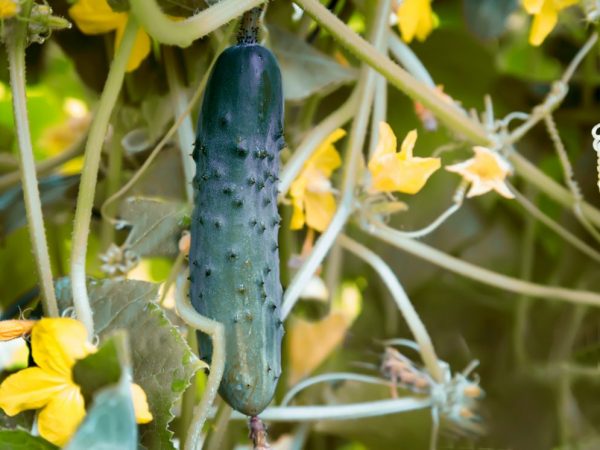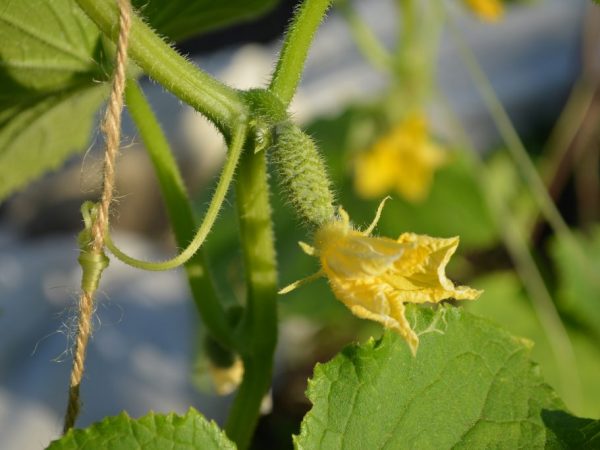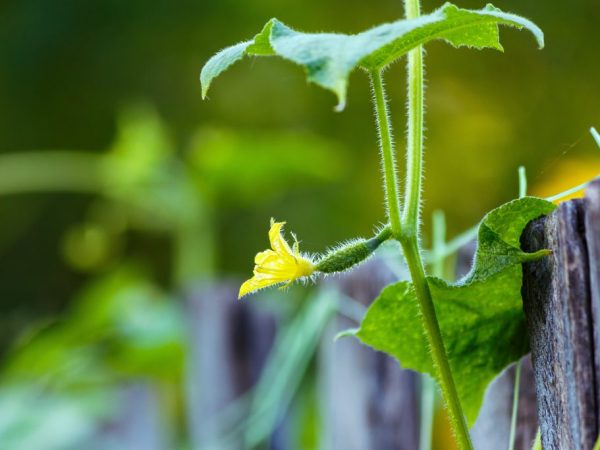How to feed cucumbers during flowering
Feeding cucumbers during flowering and fruiting is of great importance for cucumbers. During this period, they especially need nutrients. What substances to introduce and in what quantity depends on the soil, the rate of development of the culture and climatic conditions.

Top dressing of cucumbers during flowering and fruiting
Features of feeding
Top dressing is carried out from planting the seed to the removal of the last fruit from the garden.
Rules for feeding cucumbers, flowering and fruiting times (setting and forming fruits):
- Alternate the addition of organic and mineral substances.
- Do not use all available fertilizers at the same time.
- Feed the plants at the same time as watering.
- Observe the breaks between nutrient additions.
- Use root and foliar dressings, depending on the weather.
- Do not overfeed your plants with any type of nutrient.
Root dressing
Often, weather conditions make adjustments to the process of feeding cucumbers.
It is best to apply root nutrients when the weather is dry and hot. Cucumber bushes consume a lot of moisture, so root nutrition in such weather, combined with watering, has a beneficial effect on the harvest.
Foliar dressing
The introduction of micro- and macroelements is carried out every 5-7 days throughout the entire period of flowering and fruiting.
In cloudy wet weather, foliar dressing is used. Spraying solutions for cucumber beds should be less concentrated to avoid scalding on plant leaves.
Top dressing during flowering
Yellow flowers appear on cucumber seedlings. They are pistillate and staminate. The second, the so-called male, do not give ovaries. Without them, ovaries do not appear in female, pistillate, flowers.
During this period, the foundation is laid for the future harvest. If the plant has a lot of barren flowers, and there are few flowers with ovaries, the number of fruits that can be removed from the garden will be very small, so you should not neglect the introduction of the necessary micro and macro elements under the cucumber bushes during this period.
Recipes

You can prepare top dressing yourself
During the flowering period, cucumbers are fed with nutritious mixtures, which include potassium, phosphorus, nitrogen. At the same time, we must not forget about other nutrients. To provide plants with the necessary substances, gardeners use both dry mixtures and liquid solutions.
The recipe for feeding cucumbers during flowering: for 1 part of potassium salt, take 3 parts of ammonium nitrate and 4 parts of superphosphate. This mixture is laid in the grooves made between the rows of flowering cucumber bushes, after which they are watered and sprinkled with dry earth.
A boric acid solution is also used at the rate of ¼ part of a tablespoon per 10 liters of water. This solution is sprayed with cucumber beds, which are already blooming profusely.
Along with the compositions of our own production, there are ready-made mixtures produced by chemical plants. Phosphorus-based mixtures and solutions are easy to use. In order not to harm the cucumber beds, you must strictly adhere to the dosages indicated by the manufacturer.
The introduction of nutrients during the flowering of cucumbers is carried out twice: at the beginning of flowering and at the end of the formation of flowers. Together with the introduction of fertilizers into the soil, foliar nutrition of cucumber beds is also used.
Top dressing during fruiting
The long-awaited period of plant development is the appearance of the first fruits. At this point, the culture needs more nutrition than before, because the cucumber takes up a lot of nutrients.
The cucumber beds continue to feed. It is recommended to apply nutrients twice at the fruiting stage of the plant.
The first feeding of cucumbers during fruiting should be done as soon as the ovary appears on the plant. This is done to improve the taste of the crop. The second application of nutrients is carried out when the volume of the harvested crop from the beds decreases. This procedure is designed to prolong the fruiting period of cucumber bushes.
Recipes

Fertilizers must be used with care
Feeding cucumbers during fruiting is of great importance. Now cucumbers need nitrogen, potassium and magnesium, so there is a huge number of ready-made fertilizers produced by chemical plants on the market.
Experienced vegetable growers recommend using:
- urea;
- compost;
- superphosphate;
- ash;
- chicken droppings.
The main rule is not to apply all fertilizers at the same time: this will lead to the oppression of the plant, its destruction.
Potassium
During the fruiting period, cucumbers need more potassium. It affects the taste of cucumber fruits, increases the degree of resistance to garden pests and diseases.
The plant signals the lack of this element as follows:
- abundant formation of green mass, no ovaries;
- the plant acquires a dark green color;
- the appearance of a dry yellowish-gray border on the leaves.
- pear-shaped fruit.
To replenish potassium supplies, gardeners feed cucumbers with potassium sulfate. The powder is highly soluble in water and does not contain chlorine. If you add 10 g of potassium sulfate to a bucket of water and water the plants with this solution, the vegetable crop will receive a sufficient portion of potassium.
When feeding with potash fertilizers, first water 2-3 bushes, wait 2 days, assess the condition of the plant. If the appearance of the cucumber has improved, fertilize is applied throughout the cucumber patch, otherwise a different nutrient solution is used.
Nitrogen (urea)
To supply the plant with nitrogen, a urea solution is used. To do this, take 30 g of fertilizer, dissolve it in a bucket of water, after which the cucumber beds are poured with the resulting solution. For spraying, the concentration of the solution is reduced, the urea content is reduced by 2 times.
Chicken droppings
Chicken droppings are a very good fertilizer for cucumber beds. A mother liquor is made from it at the rate of 20 parts of water per one part of fertilizer. For feeding cucumbers, 2 liters of uterine infusion are diluted in 10 liters of pure water.
Bread dressing
Nowadays, feeding cucumbers with bread yeast is gaining wide popularity. 1 kg of such yeast is dissolved in 10 l of water, and then the plants are watered with the resulting solution. Many vegetable growers speak out positively in favor of such an innovation, but yeast does not contain in the composition all the substances necessary for garden crops, therefore, it is impossible to replace all plant nutrition with yeast.
Conclusion
Timely introduction of nutrients brings good results. The process of feeding cucumbers during flowering and fruiting does not require much effort. The main thing is to find the right feeding recipe.If you follow the recommendations, you can really get a rich and healthy harvest.


